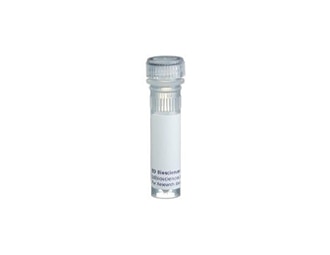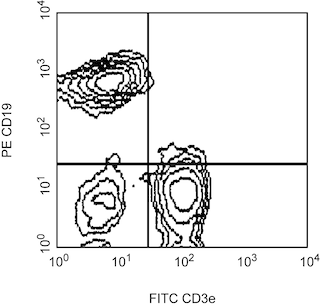Old Browser
This page has been recently translated and is available in French now.
Looks like you're visiting us from {countryName}.
Would you like to stay on the current country site or be switched to your country?




Amplification of PE-conjugated anti-mouse CD19 staining of BALB/c mouse splenocytes. Mouse splenocytes were incubated with PE Rat Anti-Mouse CD19 (Cat. No. 557399/553786) alone or followed by Biotin Mouse Anti-R-Phycoerythrin (Cat. No. 552603) and PE Streptavidin (Cat. No. 554061, right panel). The overlayed histograms correspond to stained splenocytes (shaded histogram), unstained splenocytes (left panel, unshaded histogram), or splenocytes stained with Biotin Mouse Anti-R-Phycoerythrin and PE Streptavidin (right panel, unshaded histogram). The signal-to-noise ratio of median fluorescence intensity (MFI) of the CD19+ population to the CD19- population in both panels (shaded histograms) is 87 for Panel A and 172 for right panel, demonstrating an approximate two-fold specific amplification of staining. Data shown is for gated lymphocytes based on light scatter. Flow cytometry was performed on a BD FACSCalibur™ flow cytometry system.


BD Pharmingen™ Biotin Mouse Anti-R-Phycoerythrin

Regulatory Status Legend
Any use of products other than the permitted use without the express written authorization of Becton, Dickinson and Company is strictly prohibited.
Preparation And Storage
Recommended Assay Procedures
For the amplification of PE fluorescence of PE-conjugated antibodies, it is recommended that biotinylated E31-1459 be used as a secondary antibody followed by PE-conjugated Streptavidin (Cat. No. 554061).
Product Notices
- Since applications vary, each investigator should titrate the reagent to obtain optimal results.
- Caution: Sodium azide yields highly toxic hydrazoic acid under acidic conditions. Dilute azide compounds in running water before discarding to avoid accumulation of potentially explosive deposits in plumbing.
- For fluorochrome spectra and suitable instrument settings, please refer to our Multicolor Flow Cytometry web page at www.bdbiosciences.com/colors.
- Please refer to www.bdbiosciences.com/us/s/resources for technical protocols.
Companion Products

.png?imwidth=320)
The E31-1459 antibody reacts with R-Phycoerythrin (PE), a commonly used fluorochrome for flow cytometry, alone or as a tandem conjugate with other fluorochromes (eg, PE-Cy™7). The binding of the E31-1459 antibody to PE does not quench the fluorescence of the PE molecule. The use of biotinylated E31-1459 in a three-step staining procedure with Streptavidin-PE and a PE-conjugated primary antibody can specifically amplify the PE fluorescence.
Please refer to Support Documents for Quality Certificates
Global - Refer to manufacturer's instructions for use and related User Manuals and Technical data sheets before using this products as described
Comparisons, where applicable, are made against older BD Technology, manual methods or are general performance claims. Comparisons are not made against non-BD technologies, unless otherwise noted.
For Research Use Only. Not for use in diagnostic or therapeutic procedures.
Report a Site Issue
This form is intended to help us improve our website experience. For other support, please visit our Contact Us page.